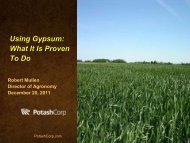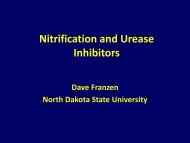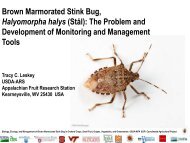Unintended Consequences of Seed-Applied Insecticides
Unintended Consequences of Seed-Applied Insecticides
Unintended Consequences of Seed-Applied Insecticides
You also want an ePaper? Increase the reach of your titles
YUMPU automatically turns print PDFs into web optimized ePapers that Google loves.
<strong>Unintended</strong> consequences <strong>of</strong> seed-appliedinsecticidesCollaborators• Greg Hunt (Honeybee ExtensionSpecialist - Purdue University)Christian Krupke• Brian Eitzer (Analytical Chemist -Connecticut Ag. ExperimentStation)Study origins• Spring 2010: Reports <strong>of</strong> dead bees at Indiana apiaries,coincided with local corn planting• Bees exhibited neurotoxic symptoms, analysis <strong>of</strong> deadbees revealed traces <strong>of</strong> thiamethoxam/clothianidin ineach case<strong>Seed</strong> treatments <strong>of</strong>field crops (primarilycorn) are the onlymajor source <strong>of</strong>these compounds…Background:Neonicotinoids and annual crops• Neonicotinoids: relatively new chemistry, widelyadopted: safe for mammals, persistent, systemic inplant tissues• Most annual crops are treated: all corn (85 millionacres), most soybeans (40+ million acres), most wheat(24 million acres), canola, cotton etc.• Clothianidin (Poncho ® ) most common in corn.Extremely toxic to honeybees (contact LD50: 22-44ng/bee, oral LD50 = 2.8-3.7 ng/bee), thiamethoxam(Cruiser ® ) also used, metabolized to clothianidin• A single Poncho 1250 corn kernel (@1.25 mg/kernel)contains enough active ingredient to kill 10,000 –100,000 honey beesBackground:Why care about honey bees?• Honey is a minor part <strong>of</strong> how bees benefit our diet• The following foods are dependent upon pollination,by (mostly) honey bees and other pollinators:• Apples, oranges, lemons, limes• Broccoli, cauliflower, cabbage• Onions, okra• Blueberries, cherries, cranberries, raspberries• Cucumbers, squashes, pumpkins• Cantaloupes, watermelons• Carrots, canola• Almonds, macadamia and other nut cropsDetermining causes <strong>of</strong> beemortality in spring 2010/11• Samples collected in 2011: dying bees, nectar andpollen from frames <strong>of</strong> affected hives• Analyzed using LC/MS-MS,screens for over 100pesticides/sample1
Understanding ppb:Analogies• Hamburgers: One Big Mac in a chain circling the equator2.5 times• Corn: One kernel <strong>of</strong> corn in a full silo measuring 45' high,16' wide• Toilet paper: One sheet in a roll stretching from N.Y.C. toLondon, England• Time: One second in 32 years• Clothianidin (Poncho ® ): contact LD50: 22-44 ng/bee, oral LD50 =2.8-3.7 ng/bee, thiamethoxam (Cruiser ® ) is toxic at similar levelsResults:Bees and frame contents• All dead/dying bees had traces <strong>of</strong> seed treatmentinsecticides• Stored pollen from hive with dead bees outside had veryhigh levels <strong>of</strong> pesticides, lower in “healthy” hivesSampleDeadbeesMean(SE)Thiamethoxam(Cruiser)Clothianidin(Poncho)Metolachlor(Dual)AtrazineND 7.9(±4.0) 2.4(±0.8) 5.7(±1.1)Healthybees ND ND ND 3.9Nectar ND ND 0.5,ND 0.3,0.6BeebreadsickhiveBeebreadhealthyhive18.5,22.3 9.1,12.4 81,82 34,392.7,9.7 2.0,3.8 26,31 15,17ND = Not detectedGoals <strong>of</strong> 2010/11 research• Investigate how/whenhoneybees are exposedto neonicotinoids usedfor treating corn seedGoals <strong>of</strong> 2010/11 research• Investigate how/whenhoneybees are exposedto neonicotinoids usedfor treating corn seedCorn planting background• Most planting throughout the Midwest occurs inlate April – early May (when fields are dry)• Most planters use a vacuum system to move/plantseeds• Treated seeds are sticky – require talc in planterto ensure uniform planting• Sampled topsoil (upper2-3”) at 4 locations/field,removed approx. 1 lb. <strong>of</strong>soil at each• Fields <strong>of</strong> known historieswere analyzed• All fields that had beencorn = treated seed,soybean = untreated seed• 5 gram subsampleanalyzed by LC/MS-MSMethods:Soil samplingSamplinglocations2
Results:Soil samples• Soil samples contained clothianidin even 2+ years afterapplication*• Half-life <strong>of</strong> clothianidin in soil is listed at 148-1155 daysSource: EPA, Office <strong>of</strong> Pesticide Programs. Factsheet Clothianidin. 2003. 19 pp.Dandelions + honeybees• Agricultural fields have abundant dandelion flowers withinand nearby in early spring• Dandelions are important early-season resource forhoneybees• Sampled flowers to determine whether pesticides are on/in dandelionsFieldhistoryThiamethoxam(Cruiser)Clothianidin(Poncho)Metolachlor(Dual)Corncorn ND 6.3 5.9 52Soysoy* ND 9.6 11.1 7.8Cornsoy ND 4.9 6.1 8.5Soycorn ND 2.1 ND 22AtrazineMethods:Dandelion sampling cont'd• Removed flowers from field borders and first 3-6’ intounplanted fields in early May 2011• Honeybees foraging on dandelions at time <strong>of</strong> sampling• Dandelions from non-ag area served as controlsResults:Soil and dandelions• Dandelion flowers from unplanted fieldsconsistently contained neonicotinoids, notfound in non-ag samples• Sampling <strong>of</strong> other plants (winter annualweeds) is underwaySample:historyDandelions:nonagareaDandelions:unplantedcornfieldsThiamethoxam(Cruiser)Clothianidin(Poncho)Metolachlor(Dual)ND ND ND NDAtrazine1.15(±0.44) 3.75(±1.34) 84(±43) 622(±162)Planter exhaust• Virtually all modern planters must use talc (typical) orgraphite to plant treated seed• Some exits with seed, some leaves the system withexhaust, remainder (ca. 30%) must be purged from thesystem following plantingExcerpt from John Deerepublication: “Ready to plant guide:Optimizing planter performance”• No information given on how/where to dispose <strong>of</strong> used talc• Rates <strong>of</strong> talc use: 80 grams <strong>of</strong> talc/bag <strong>of</strong> corn seed * 28million bags planted/year• = 2.24 million kg (5 million pounds) <strong>of</strong> talc used eachyear…3
Results:Planter exhaust (used talc)• Extremely high concentrations <strong>of</strong> seed coatings found inused talc<strong>Seed</strong>typeThiamethoxam(Cruiser)Clothianidin(Poncho)Metalaxyl(Apron)Unusedtalc ND ND ND NDTreatedseed1 735,000ppbTreatedseed2 68,000ppbTreatedseed3 13,240,000ppbTreatedseed4 70,000ppbUntreatedcornseed3,400,000ppb10,000,000ppb4,900,000ppb15,030,000*ppb116,000ppb92,000ppb263,000ppb131,000ppbTrifloxystrobin(Stratego)66,000ppb50,000ppbND 47,000ppb ND ND503,000ppb313,000ppb*=equivalentto700,000XthecontactLD50(20ng)Results:Used talc (cont'd)• Talc abrades and attaches to seed coating, particles arevery small and potentially mobile• Sifting large seed pieces out had little effect on toxicity<strong>Seed</strong>typeMixedseedlot,straightfromplanterMixedseedlot,siftedThiamethoxam(Cruiser600)Clothianidin(Poncho1250)Metalaxyl(ApronMax)11,282,000ppb 2,985,000ppb 281,000ppb8,042,000ppb 5,871,000ppb 251,000ppbLater season effects• Neonicotinoids are persistent and systemic: pollen fromtreated seed expresses low levels <strong>of</strong> neonicotinoids in othercrops (canola)• Honeybees that consume water droplets from plants grownfrom treated corn seed will die in lab• No published studies <strong>of</strong> corn pollen foraging or effectsPollen analyses• Hives placed in/near corn fields with pollen traps installed• Quantified levels <strong>of</strong> pesticides in collected pollen anddetermined fraction <strong>of</strong> corn pollen collected by bees• Focused upon period <strong>of</strong> peak pollen shedPlantainpollenCorn pollenPollen samples:Treated vs. untreated corn• Collected pollen from 100 plants in field, grown fromtreated and untreated seed• Low levels <strong>of</strong> neonicotinoids and fungicides detected inpollen grown from treated seeds• But will bees collect corn pollen?CornPlantTypeThiamethoxam(Cruiser)Clothianidin(Poncho)Metalaxyl(Apron)Treatedseed 2.1ppb 2.6ppb* 3.7ppbUntreatedseed ND ND ND*Equivalentto2.6ng/gram,theoralLD50forclothianidinis 2.8ng<strong>of</strong>clothianidin/beeResults:Bee-collected pollen analysis• Bees collected surprisingly high levels <strong>of</strong> corn pollen whenavailable• Many samples left to analyze…Corn pollenHIVEIDRange:%cornpollen(mean±SE)Untreated1 1682(58±12)Untreated2 973(48±11)Treated1 1876(48±12)Treated2 343(24±7)Means/totals 44.5(±5.7)4
Bee-collected pollen analysis: Pesticides• Half <strong>of</strong> the pollen samples analyzed to date containedthiamethoxam, clothianidin or both• All contained fungicides, applied aerially during pollen shed• Fungicides in this family synergize neonicotinoid toxicity inhoneybeesHIVEIDMeanconcentrations(SE),ppb(#sampleswithdetection)Thiamethoxam(Cruiser)Clothianidin(Poncho)Untreated1 ND 4.0(1/5)Untreated2 ND 4.9(±2.3)(4/5)Propiconazole(Tilt)17.5(±6.0)(5/5)10.8(±1.9)(5/5)Treated1 ND ND 9.7(±3.6)(5/5)Treated2 2.18(3/5)27.8(±15.4)(4/5)7.5(±1.2)(5/5)Azoxystrobin(Quadris)29.2(±13.5)(5/5)15.6(±4.2)(5/5)19.7(±11.6)(5/5)12.1(±4.7)(5/5)Worker longevity experiments• Goal: Quantify effects <strong>of</strong> living near treated/untreatedcorn upon worker longevity• Placed 4 hives at each location (treatment):1) Non-agricultural area (Gravel pit)2) Adjacent to neonicotinoid-treated corn (TPAC)3) Adjacent to untreated corn (TPAC)• Two hives/location with pollen traps installed tosample pollen weekly• Two hives/location with marked workers introduced at2 intervals: 1) planting time, 2) at corn silking• Correlate worker longevity with pollen entering hiveat various periods through seasonColony-level effectsWorker longevity experiments• Pollen is primary proteinsource for bees• After eclosion, youngworkers feed on storedpollen - consumeapproximately 65 mgover 10-d period• Effects <strong>of</strong> consumingcontaminated pollen?Stored pollen• Introduced 250 paintmarked,24-h oldworkers to each hive• Each frame removedand photographed• Photos 24-h afterintroduction(baseline), then 7, 14,21 days afterintroduction• Conductedimmediately afterplanting and duringcorn pollen shedResults: Forager longevityduring pollen shed• No rapid intial mortality – mortality curves were initiallysimilar• Possible reduced lifespan in/near cornfields?• May have ended prematurely...revisit in 2012<strong>Seed</strong> treatments are labeled for control <strong>of</strong> manypests…ProportionsurvivingCorn rootwormBlack cutworm<strong>Seed</strong>corn maggotWhite grubWirewormAndmany,manymore!5
Benefits <strong>of</strong> neonicotinoidtreatedseed?• Labeled for a variety <strong>of</strong> early-season pests,mainly soil insects• Efficacy is highly variable, very fewindependent efficacy studies• Do we need seed treatment on all cornplanted in North America? What are the costsvs. benefits?• Remember IPM? Applications <strong>of</strong> seedtreatments are not based on any monitoring/thresholds etc.Where/when do bees and corn overlap?Mostmanagedpollinatorsin the USspend MaythroughOctober inMN, ND, SDSummary• Honey bees living near fields where treated seeds areplanted have multiple routes <strong>of</strong> exposure toneonicotinoid insecticides throughout spring andsummer• Exposure may be by contact (dust, soil), by ingestion(corn and other pollen), and is likely a combination• Talc from planter exhaust is highly toxic, mobile and anobvious target for mitigation• Sub-lethal effects, synergies with other pesticides maybe important in evaluating overall effectsNow:Next steps• Determine how to limit movement <strong>of</strong> dust <strong>of</strong>f <strong>of</strong>planting equipment and away from planting area• Evaluate other non-target effectsLater:• Examine when/where seed treatments are necessaryin crop productionLimits non-target exposure, increases durability <strong>of</strong>insecticides (avoid resistance) and maximizesproducer return on investmentAcknowledgements:PeoplePlot prep/hive maintenance/pollen counts:• Krispn Given• Nick Seiter• Gladys Andino• Caitlin Race, Madeline Spigler, Nicole Parker• Larry Bledsoe• Pete IllingworthAcknowledgements:Funding NAPPC Grant to CK AFRI Managed Pollinator Grant to GHPhotos/videos• John Obermeyer6






